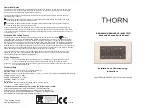
.
Observe
Important
Wiring
Information
Important:
This
switch
is
rated
for
and
intended
to
only
be
used
with
copper
wire.
The
home’s
electrical
wires
may
be
attached
to
the
screw
terminals
or
inserted
into
the
holes
in
the
back
of
the
switch
enclosure
and
clamped
in
place
by
tightening
the
screw
terminals.
Always
follow
the
recommended
wire
strip
lengths
when
making
wiring
connections.
Wire
gauge
requirements
•
Use
14
AWG
or
larger
wires
suitable
for
at
least
80°
C
for
supply
(HOT),
Load,
Neutral,
Ground
and
Traveler
connections.
Wire
strip
length:
•
For
attachment
to
screw
terminals:
Strip
insulation
1
in
(25mm)
•
For
attachment
using
the
enclosure’s
holes:
Strip
insulation
5/8”
(16mm)
UL
specifies
that
the
tightening
torque
for
the
screws
is
14
Kgf
‐
cm
(12
lbf
‐
in).
SINGLE
SWITCH
WIRING
1.
Shut
off
power
to
the
circuit
at
fuse
box
or
circuit
breaker.
2.
Remove
wall
plate.
!
Warning:
Verify
power
is
OFF
to
switch
box
before
continuing.
3.
Remove
the
switch
mounting
screws.
4.
Carefully
remove
the
switch
from
the
switch
box.
DO
NOT
disconnect
the
wires.
5.
There
are
five
screw
terminals
on
the
switch;
these
are
marked
LINE
(Hot)
Neutral
LOAD
GROUND
TRAVELER
The
Traveler
terminal
is
only
used
for
3
‐
way
or
4
‐
way
wiring
and
should
remain
insulated
if
the
switch
is
being
installed
in
a
2
‐
way
system
(one
switch
&
one
load).
Match
these
screw
terminals
to
the
wires
connected
to
the
existing
switch.
6.
Disconnect
the
wires
from
the
existing
switch.
7.
Connect
the
green
or
bare
copper
ground
wire
to
the
GROUND
terminal.
8.
Connect
the
black
wire
that
goes
to
the
light
to
the
terminal
marked
LOAD.
9.
Connect
the
black
wire
that
comes
from
the
electrical
service
panel
(Hot)
to
the
terminal
marked
LINE.
10.
Connect
the
white
wire
to
the
neutral
terminal.
Note:
UL
specifies
that
the
tightening
torque
for
the
screws
is
14
Kgf
‐
cm
(12
lbf
‐
in).
11.
Insert
Switch
into
the
switch
box
being
careful
not
to
pinch
or
crush
wires.
12.
Secure
the
switch
to
the
box
using
the
supplied
screws.
13.
Mount
the
wall
plate.
14.
Reapply
power
to
the
circuit
at
fuse
box
or
circuit
breaker
and
test
the
system.


























